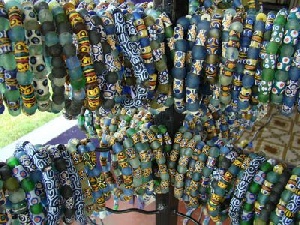Some years ago, beads were mainly used by royals, women and some particular tribes in Ghana but recently, both men and women, children and adults seem to have developed some heightened liking for beads.
The days when beads were used for voodoo rituals due to their magical and medicinal powers is gone. Today, people use beads for adornment. After the introduction of Friday wear or African wear by ex-President Kuffuor, most people have found beads as suitable accessories to complement their outfits.
There are even some people who wear typical Africa beads on western attires, and they look resplendent in such outfits. Some fashion designers also embroider beads onto their fabrics. Among most women, beads are worn with the intention of attracting the opposite sex.
They wear beads around their waists, hiding them under their clothes. Most men find it attractive to see their girlfriends and wives wear beads around their waists. They say seeing beads on the waists of their women get them closer to the women and turns them on.
Some women also say wearing the beads around their waists help check their weights. According to them, if they put on weight the (beads) will be very tight around their waists. On the other hand, if they lose weight they will become loose.
Found back-dating 38,000 years, beads have been made from pebbles, shells, teeth, claws, clay, glass, cloth, pith, and more. The word bead comes from the Anglo Saxon words bidden (to pray) and bede (prayer).
Prayer beads are known world-wide, and help the user recite prayers and keep track of the sequence and number of the prayers. Beads continue to be used as talismans to protect the wearer against evil, and as amulets to bring wisdom and fortune.
Used for prayers, protection, worries, money or adornment, beads have been important to us for a very long time. From as early as the fifteenth century, glass beads were imported from Italy to adorn Chiefs and Queens and used in ceremonies that marked a rite of passage.
More recently, Ghana has begun to export locally made beads to Italy, Denmark and some other foreign countries as a means of boosting the economy.
Krobodan Beads Limited, a Krobo-Danish partnership of bead making in the Yilo Krobo Municipality of Ghana, was established in 2007 to promote rural development by adding value to handicrafts (glass beads, glass beaded jewellery and others) for the domestic and the international markets.
The company was established to sustain the beads work in a micro credit project sponsored by DANIDA from 2005-2008.
The Krobo Danish Association has been a centre where simple and practical alternative livelihood are taught, a centre using alternative livelihood as a banker for the poor, a center using alternative livelihoods as a surest means of poverty reduction.
But how much do these beads cost? Yaa Tsibua, a marketer of beads at the Beads Market in Koforidua, says the prices range from GH¢4 to GH¢40, and these prices depend on whether they are necklaces, anklets, bracelets or pendants.
To those who sell beads in large quantities to foreign countries, it`s a lucrative business.
Sadly, this is an area of the creative arts most people especially shy away from talking about. Bead making is a source of livelihood for most people, and it is right that issues concerning them are also brought to the fore.
With our aim of developing the entire creative arts industry, Flex newspaper promises frequently to write more about some of these arts sectors that have been relegated to the background.
Fashion of Wednesday, 13 August 2014
Source: Flex Newspaper

















